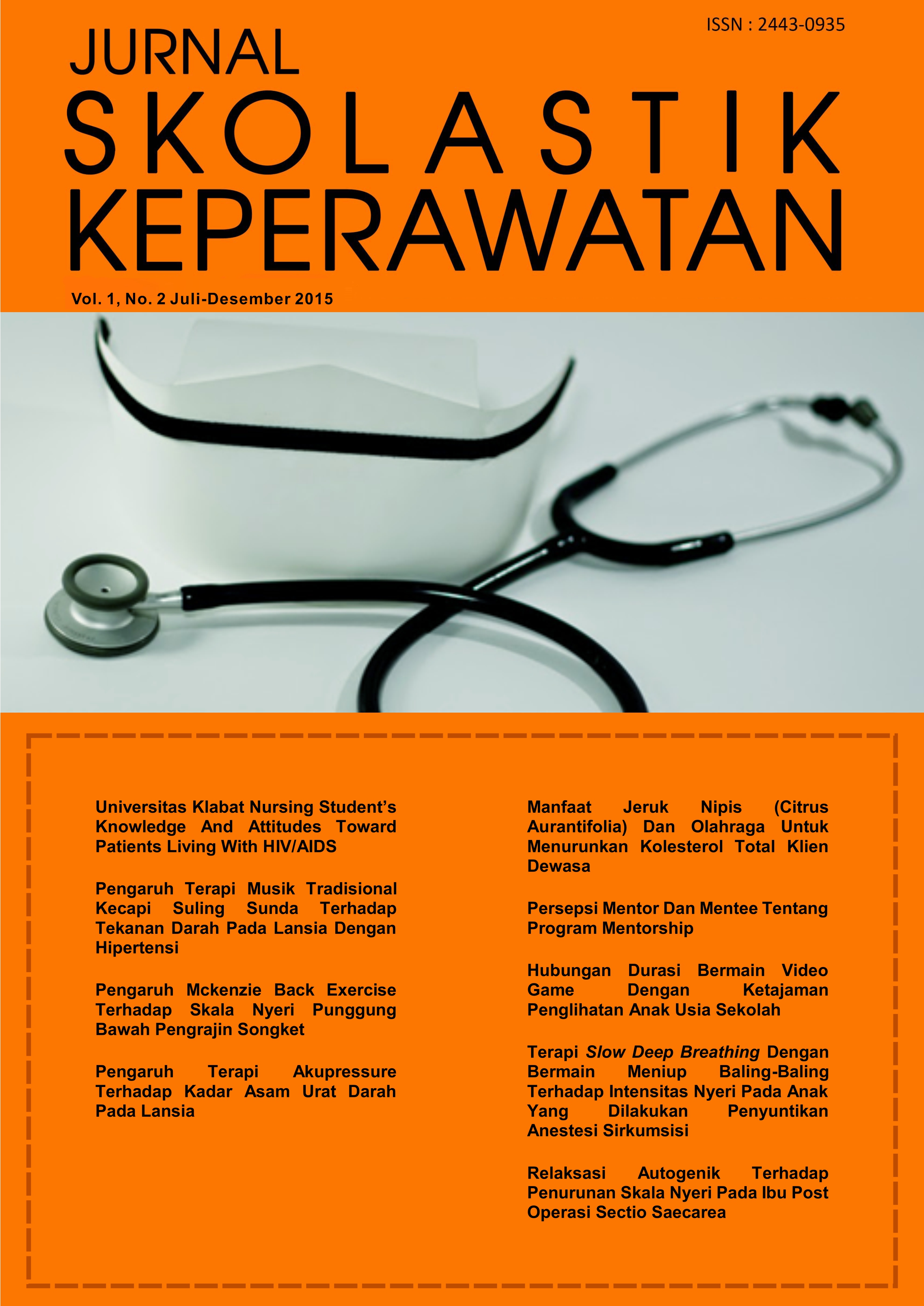TERAPI SLOW DEEP BREATHING DENGAN BERMAIN MENIUP BALING-BALING TERHADAP INTENSITAS NYERI PADA ANAK YANG DILAKUKAN PENYUNTIKAN ANESTESI SIRKUMSISI
Keywords:
Anak, Nyeri, Penyuntikan anestesi sirkumsisi, Slow deep breathingAbstract
ABSTRAK
Pendahuluan: Sirkumsisi merupakan tindakan yang memerlukan persiapan, salah satunya tindakan anestesi. Selama sirkumsisi, rasa nyeri akan dirasakan hanya pada saat penyuntikan anestesi. Perawat sering kesulitan melakukan prosedur penyuntikan anestesi sirkumsisi karena anak sering menolak dilakukan tindakan keperawatan yang akan menimbulkan rasa nyeri. Salah satu manajemen non farmakologi untuk menurunkan nyeri pada anak adalah terapi slow deep breathing sambil bermain meniup baling-baling. Tujuan: mengidentifikasi pengaruh terapi slow deep breathing dengan bermain meniup baling-baling terhadap intensitas nyeri pada anak yang dilakukan penyuntikan anestesi sirkumsisi. Metode: Penelitian ini menggunakan quasi eksperimental dengan control group post test. Populasi penelitian ini adalah seluruh anak yang dilakukan penyuntikan anestesi sirkumsisi di Klinik Khitan Kencana Medika. Sampel yang digunakan berjumlah 36 anak, 18 anak kelompok intervensi dan 18 anak kelompok kontrol. Respon nyeri diukur menggunakan Faces Pain Rating Scale. Hasil: penelitian dianalisis menggunakan uji Mann-Whitney menunjukkan ada perbedaan yang signifikan antara kelompok intervensi dan kontrol dengan p-value < 0,001 dan nilai signifikansi alpha £ 0,05. Kesimpulan penelitian ada pengaruh terapi slow deep breathing dengan bermain meniup baling-baling terhadap intensitas nyeri pada anak yang dilakukan penyuntikan anestesi sirkumsisi.
Â
Kata kunci: anak, nyeri, penyuntikan anestesi sirkumsisi, slow deep breathing
Â
ABSTRACT
Introduction: Circumcision is treatment which needed preparation, one of them is anesthesia treatment. As long as circumcision treatment, pain will be feel only at the time anesthesia circumcision injection. Nurses often have difficult to make action procedure of anesthesia circumcision injection because children often refuse to procedures which will occurs pain feeling. One of non pharmacology managements to reduce pain on children by giving children breath is playing with a blow vane. Objective: The purpose of study to identify the effect of slow deep breathing therapy by playing with a blow vane to pain intensity on children with anesthesia circumcision injection. Methods: This study used a quasi experimental design by control group post test. Populations were all children who had been performed anesthesia circumcision injection in Kencana Medika Circumcision Clinic. Used 36 samples consist of 18 samples were in intervention and control group. Pain response was measured by Faces Pain Rating Scale. Result: The results were analyzed using the Mann-Whitney showed there are significant differencebetweenthe interventionandcontrolgroups with ap-value of0.000 and α £ 0.05. The conclusioniseffect of slow deep breathing theraphy by playing with a blow vane to pain intensity on children with anesthesia circumcision injection.
Keywords: anesthesia circumcision injection, children, pain, slow deep breathing
Â
Full printable version: PDF
Downloads
References
Bagheriyan, S, Borhani, F, Abbaszadeh,A &Ranjbar, H. (2011). The effects of regular breathing exercise and making bubbles on the pain of catheter insertion in school age children. Iran J Nurs Midwifery Res. 2011 Spring; 16(2): 174–180.
Kirby, L.A, Olivia, R & Sahler, O.J.Z. (2010). Music therapy and pain management in pediatric patients undergoing painful procedures: a review of the literature and a call for research. Journal of alternative medicine research volume 2, Issue 1, Specialist Issue pp 7-16.
Lalehgani,H., Esmaili,S., Karimi,M., (2013). The effect of deep-slow and regular breathing on pain intensity of burn dressing. Iran J Crit Care Nurs, 6(4):229-234
Nordin,M. (2002). Self- care techniques for acute episodes of low-back pain. Best Practice & Research Clinical Rheumatology,16(1):89-101;Jan 2002.
Russell, K. (2013) Pain Management for Immunisation. Counties Manukau Health
Sutini. (2013). Penerapan fisika pada permainan: Baling-baling kertas mudah berputar dengan ditiup. http://www.crayonpedia.org/mw/Membuat_Kincir_Angin_Sederhana_Diakses 1 Januari 2014.
Syamsuddin, A. (2009). Efektifitas terapi relaksasi napas dalam dengan bermain meniup baling-baling untuk menurunkan tingkat nyeri pada anak post perawatan luka operasi di dua Rumah Sakit di Banda Aceh, Nanggoe Aceh Darussalam. Tesis tidak dipublikasikan.
Taddio, A & Appleton, M. (2009). Help eliminate pain in kids clinical practice guideline for pain management during childhood immunizations. Technical report.
Taddio,A ., Appleton, M., Bortolussi, R., Shah, V., Chambers, C. (2010). Reducing the pain of childhood vaccination: on evidence-based clinical practice guideline. CMAJ 182 (18)
Tarwoto. (2011). Pengaruh latihan slow deep breathing terhadap intensitas nyeri kepala akut pada pasien cedera kepala ringan. UI Tesis.
Wong, D.L., Hockenberry-Eaton, M., Wilson, D., Winkelstein, M., & Schwartz, P. (2009). Buku ajar keperawatan pediatrik (6th ed).Jakarta: EGC.
Downloads
Published
How to Cite
Issue
Section
License
Copyright (c) 2021 Hesti Wahyuni, Setyawati Setyawati, Iin Inayah

This work is licensed under a Creative Commons Attribution-NonCommercial-ShareAlike 4.0 International License.
Authors who publish with this journal agree to the following terms:
- Authors retain copyright and grant the journal right of first publication with the work simultaneously licensed under a Creative Commons Attribution-NonCommercial-ShareAlike 4.0 International (CC BY-NC-SA 4.0) that allows others to share the work with an acknowledgment of the work's authorship and initial publication in this journal.
- Authors are able to enter into separate, additional contractual arrangements for the non-exclusive distribution of the journal's published version of the work (e.g., post it to an institutional repository or publish it in a book), with an acknowledgment of its initial publication in this journal.
- Authors are permitted and encouraged to post their work online (e.g., in institutional repositories or on their website) prior to and during the submission process, as it can lead to productive exchanges, as well as earlier and greater citation of published work (See The Effect of Open Access).









